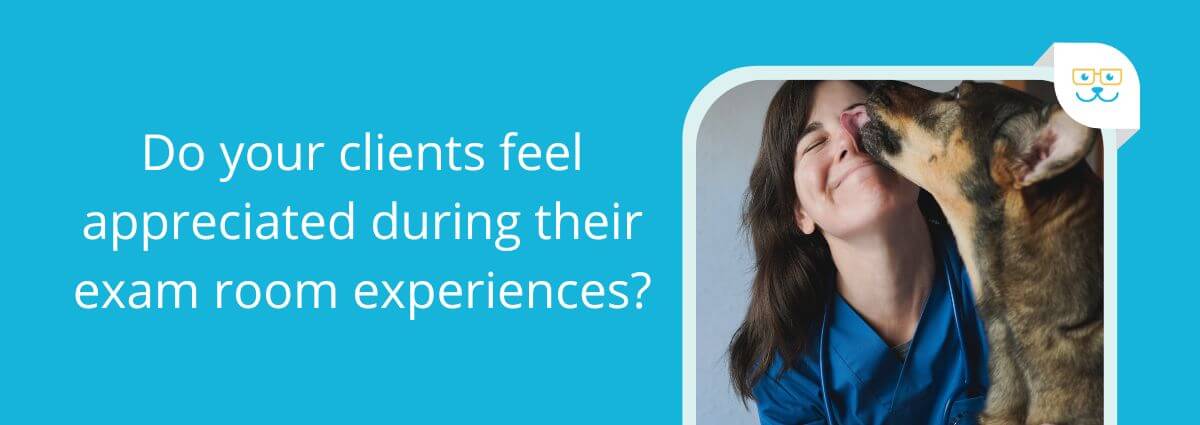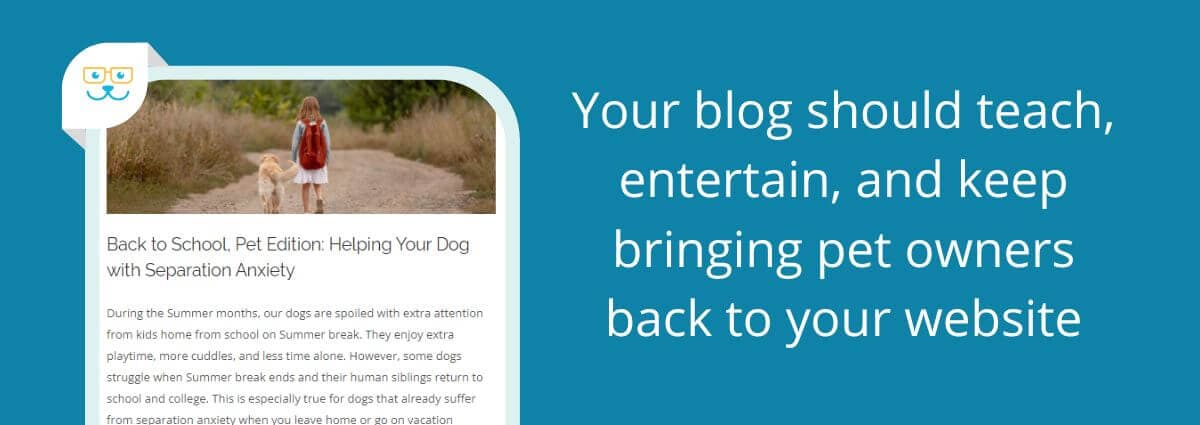Understanding The Customer Journey
Article By: David Hall, Co-Founder
Over the past decade, veterinary marketing has completely changed. Mobile phones have put the internet in the palm of everyone’s hand, text messaging and social networks have completely changed the way people communicate, and websites like Yelp have turned everyone into a reviewer—these channels offer opportunities to connect with pet owners in your local community like never before. But, the first step in using these channels effectively is understanding how your clients are using them.
Take a quick look at the following 1-minute video and allow it to serve as an example customer journey, demonstrating the process prospective customers go through and the digital touchpoints they interact with as they move toward becoming your clients.
While the video presents a streamlined, high-level perspective on the customer journey and digital touchpoints, we will do a deeper dive into the five stages of the customer journey in the rest of this article. We'll identify the different digital marketing strategies that you can implement to turn more local pet owners into clients.
The Five Stages of the Customer Journey for Veterinary Clients
Five distinct stages define the customer journey of a veterinary client. Good marketing moves the client along every step on the path to your exam room and supports that client relationship long after that first appointment. This article will discuss each stage of the customer journey and what marketing strategies you can use to ensure that your veterinary practice constantly attracts new clients while maintaining your relationship with existing clients.
Stage 1. Awareness
The first stage in the customer journey is to ensure that every dog and cat owner in your service area knows your practice exists. Building familiarity with them before their pet gets sick by providing valuable information can make a massive difference once their pet needs veterinary care. The top strategies you can use to support this are:
- Social Networks: Over 75% of American adults use social networks to connect, engage with news content, share information, and entertain themselves. Word of mouth marketing now takes place on social networks, where people ask their network for recommendations, or where your messages will gain reach into the friends and followers of anyone who likes, comments, or shares your posts.

- PPC Advertising: Pay-Per-Click advertising allows you to decide precisely what type of people you would like to see your message, and you only pay when someone chooses to click on one of those messages and visit your website. A well-managed and mature PPC campaign can guarantee a fantastic return on investment.
- Blog Articles: Consistently publishing interesting and informative blog articles relating to the services you provide and your clients' needs is one of the most critical components of modern marketing. When done right, over time, building a library of high-quality pet care-related articles on your website can give your practice an incredible advantage over your competitors.
- Content Marketing: Content marketing is where your blogging meets PPC... there are a few special advertising networks that will promote your blog articles on other news and article-related websites to get your articles in front of people already in article reading mode. We can target these ads to your local area so that they will only show up for people who are physically located in the zip codes that your practice serves. These ads are incredibly inexpensive and powerful when paired with a good set of remarketing PPC ads.
- Referrals: Referrals always have and may always be the most effective type of marketing your veterinary practice can get. Therefore, you should have a strategy that actively encourages and perhaps even incentivizes referrals. Referrals, of course, are when an existing client suggests your veterinary practice to their friends. For the most part, referrals today take place on social networks, but there are several strategies that you should have in place to maximize your opportunity for referrals.
- Community & Events: Community outreach strategies and event participation can give your practice a fun and engaging yet subtle way to support local pet owners in everyday situations while increasing exposure and awareness for your veterinary practice. Local events provide great opportunities to introduce your practice to new people within your community. However, there is a big difference between showing up at events and really making the most of your opportunities to connect and start a relationship with the people you meet at the event. It can be far more impactful to do a few events right per year than every event in town.
- New clients will look at your website before they ever step foot in your building. This is just standard practice for consumers today, and they will be making some critical judgments about your practice based on what they see on your website. If your site looks old and lacks high-quality information, they are likely to assume that your business practices and level of veterinary care are also lacking.
- Online Business Directories: These are websites that list the name, address, and phone number of your business, and they are also the websites where people go to read and write their reviews of your business. The way your practice is represented in these online directories has a significant impact on the first impressions of prospective customers. They also have a substantial effect on your performance in Google search results, so this is an area that you cannot ignore.
- Social Networks: Of course, they play a role in the initial "awareness" phase of the customer journey, but social networks also play a significant role in consideration. Prospective clients are highly likely to look at your presence on Facebook, Instagram, Twitter, or YouTube, and what they see there will affect their impression of your practice. If they find that your local competitor seems far more engaging, professional, and fun in their social posts, it can easily sway their decision of who to call.
- Phone inquiries: It is so important that phone inquiries are handled by an amazing front staff who appreciate and understand that every phone call and potential customer should be treated with exceptional service every time. Suppose the average lifetime value of a client in a veterinary practice ranges from $4,000-to $10,000. In that case, that means that every first-time caller is potentially worth that much money, and that is worth sitting up, taking notice, and ensuring your customer service is impeccable.

Stage 3. Appointment
The third stage will determine whether or not a new client appreciates and values your services. This stage is all about creating an excellent client experience and solidifying their trust. Touch points include:
- Appointment Setting and Reminders: Whether an appointment is set through a phone call or filling out a form online, it is critical for your practice to ensure that clients show up for their appointments, and communication in the form of reminders is a vital tool in supporting that effort.
- Waiting Area: When a client shows up in your practice, what are you doing to ensure that the time they spend in your waiting area is fun and engaging? This time presents a valuable opportunity to build and strengthen the client's relationship with your practice.
- Check-In on Social Networks during their visit: When a client is in your practice, if you can get them to "check-in" on social networks, post a picture, and tag your practice... that will get seen by many of their friends and neighbors and give your practice some compelling word of mouth marketing.
- Exam Room: The messaging that a client sees and hears, their processes, and their overall experience in the exam room are paramount to setting expectations and following through (continuity) for that client. You want to make sure that you create an environment, messaging, and processes that will naturally help that client have an experience that makes them feel appreciated, valued, loved, well cared for, and engaged.

- Treatment: High-quality treatment starts and ends with trust. The more a client trusts the information they are getting and the people giving it to them, the more likely they are to follow through with your recommendations and instructions for care, thus making it more likely their pet will get the care they need.
- Handouts and information: Providing a client with information that reinforces your recommendations leads to better follow-through and continuity of care. Whether your practice hands out printed information or sends an email with links to information that can be found on your website, having an abundance of information that supports your recommendations can help build trust with a client.
- A well-trained staff who knows how to make each client feel valued, appreciated, and cared for: Of course, there is nothing more important than this—a veterinary practice can only provide excellent client service and grow based on its coordinated efforts staff. Unfortunately, many veterinary practices lose sight of this in the flurry of day-to-day activities and stresses. Investing in your people and the culture of your practice is and will always be the best investment you can make.
Stage 4. Retention
It is 10x more costly to get a new client than to keep an existing one. Successful veterinary practices rely on customers returning again and again to build lifetime customer value. The types of marketing activities that support this are:
- Forward Booking Appointments: For most veterinary practices, the majority of exams come from appointments that have been scheduled (as opposed to walk-ins). Therefore, the number one objective of marketing is to get clients to schedule appointments. Well, if a client is already in your office, there is no better time for them to book their next appointment. Asking clients to schedule their next appointment before they leave your office can and should be the number one strategy contributing to your continuity program.
- Phone Calls & Text Messages: Calling and texting clients to remind them of an upcoming appointment can significantly improve your no-show rate. However, an often overlooked retention strategy is to make sure that someone from your staff calls every active client your practice has at least once every six months to check in on them and their pet.
- Post Mail: While digital marketing channels have become the top way to get in front of clients across all demographics, sending post-mail can still be an effective way to increase your monthly appointment numbers. However, just because this is an offline strategy doesn't mean it's completely removed from your other digital strategies. The messaging in your mailer should be very congruent with your online messaging and should incorporate a call tracking number and the address of a particular landing page on your website to track the effectiveness of every piece you put in the mail.
- Email and Newsletters: Staying top-of-mind is the name of the game when it comes to retention, and emailing newsletters to clients can be a very effective way for you to accomplish this. However, for this strategy to work, the information you send needs to be highly relevant to the person you are sending it to. For starters, you should have different newsletters that go out to dog owners, cat owners, and people who own both.
- Blog Articles: Consistently providing high-quality, informative, and engaging content in the form of blog articles gives your existing clients an excellent reason for coming back to your website again and again and keeps you positioned as their go-to pet care expert.

- Information & Guides: Providing clients with guides on how to be better pet owners can give your practice a place at the table throughout the lifetime of that pet.
- Social Networks: Social posts are one of the best ways to keep fun and engaging messages in front of your clients. In fact, Facebook and Instagram both make it incredibly easy to set up a custom audience based on a list of your existing clients and get posts in front of them very inexpensively.
- Targeted PPC Marketing: If you want to make absolutely positive that your message is getting in front of your existing clients, that can easily be done through targeted pay-per-click marketing.

Stage 5. Advocacy
Stage five of the customer journey is all about turning your clients into evangelists for your practice. Word of mouth marketing today relies heavily on digital channels. Therefore it is essential to recognize this and actively encourage your clients to:
- Leave Positive Online Reviews: Reviews of your business will be posted online whether you like it or not and whether you participate in the conversation. But it is infinitely better for you, your business, your existing client relationships, your future client relationships, and for your ability to recruit and retain staff if you do a great job participating in these online review forums. Because of the reach and impact of these review websites, knowing when and how to respond to every type of review is more critical than ever before.

- Engage with your social posts and tell their friends and neighbors about you: When existing clients engage with your social posts by liking, commenting, or sharing, that helps your message spread into their sphere of influence. So, the important thing to remember is to actively seek to create posts that engage your clients in social networks and do a great job participating in those social conversations. And that's because many of your future clients will learn about your practice for the first time as these conversations pass through their social feeds.
Putting Digital Marketing to Work For Your Practice!
A great veterinary marketing program will use all of these strategies to support every stage of the customer journey, finding new clients in your local community, leading them to your door, keeping them coming back, and recommending you to their friends. If you are interested in putting these strategies to work for your practice, GeniusVets is here to help!
Schedule a demo to learn more about how GeniusVets can help you hire and retain the best of the best while improving your profitability.

